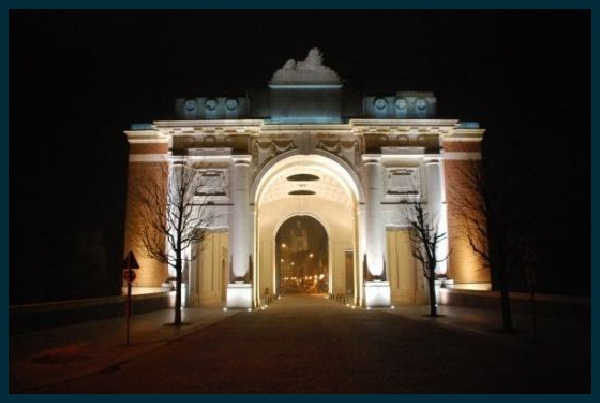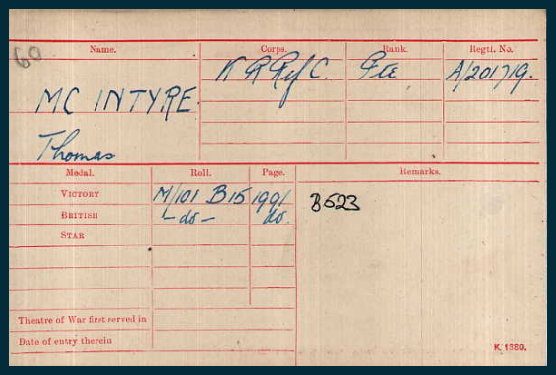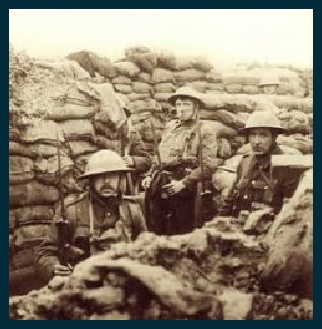Copyright © All rights reserved.



Thomas McIntyre

Thomas McIntyre was born on 30th January 1876 and baptised as a Catholic on 4th February 1876 at Our Blessed Lady Immaculate, Washington County Durham. He was the eldest son of James and Barbara McIntyre. James may have been an immigrant from Ireland working as a labourer, presumably at Penshaw Quarry and in 1881 was living with Barbara and their four children at Penshaw Cottage, an area midway between the quarry and the Pit.
1881 Census – resident at Cottage, Penshaw, County Durham
MC INTYRE, James, Head, Married, M, 36, Quarry Labourer, Sligo Ireland,
MC INTYRE, Barbara, Wife, Married, F, 32, , Newcastle on Tyne Northumberland,
MC INTYRE, Mary E, Daughter, Single, F, 12, Scholar, High Barmston Durham,
MC INTYRE, Margaret, Daughter, Single, F, 9, Scholar, Patteson Town Durham,
MC INTYRE, Thomas, Son, Single, M, 4, , Coxgreen Durham,
MC INTYRE, Elizabeth, Daughter, Single, F, 1, , High Barmston Durham,
By 1891 James was working at the neighbouring coalmine as a checker on the screens, and Thomas is also working there as a driver (presumably of waggons).
1891 Census – resident at Cox Green, Painshaw (Penshaw), Houghton-
MCINTYRE, James, Head, Married, M, 47, Checker On Screens At Pit, Workington Cumberland,
MCINTYRE, Barbary, Wife, Married, F, 43, , Newcastle Northumberland,
MCINTYRE, Thomas, Son, Single, M, 14, Driver In Pit, Co Durham Cox Green,
MCINTYRE, Eliz, Daughter, , F, 12, , Washington Co Durham Bank Top,
MCINTYRE, Kate, Daughter, , F, 6, Scholar, Co Durham Cox Green,
By 1901 Thomas had moved out and was continuing to work with horses as a stable lad at the Racing stables at Spring Cottage in Norton.
1901 Census – resident at Spring Cottage, Norton
LUND, Charles, Head, Widower, M, 54, Trainer Of Racehorses, Malton Yorkshire,
LUND, Thomas S, Son, Single, M, 19, Assistant Trainer Of Racehorses, E R Norton Yorkshire,
GUEST, Minnie, Servant, Single, F, 34, Housekeeper (Domestic), Scackleton Yorkshire,
FREER, Elizabeth, Servant, Single, F, 29, Housemaid (Domestic), Rillington Yorkshire,
WALKER, John, Servant, Single, M, 50, Stableman (Training Stables), Newcastle on Tyne Northumberland,
WILEY, Robert, Servant, Single, M, 22, Stableman (Training Stables), Alnwick Northumberland,
HARRISON, Thomas, Servant, Single, M, 23, Stableman (Training Stables), Beverley Yorkshire,
SWALE, Harry, Servant, Single, M, 20, Stableman (Training Stables), Battersea London,
DAVIDSON, Arthur, Servant, Single, M, 22, Stableman (Training Stables), Coundon Durham,
HEMMINGS, Urbin, Servant, Single, M, 24, Stableman (Training Stables), N K Yorkshire,
MCINTYRE, Thomas, Servant, Single, M, 23, Stableman (Training Stables), Gateshead Durham,
GIBSON, Joseph, Aprentice, Single, M, 18, Stable Boy (Training Stables), Willington Square Northumberland, DUCKWORTH, Charles, Aprentice, Single, M, 17, Stable Boy (Training Stables), Doncaster Yorkshire
He married Hannah Sadler in the second quarter of 1905 in Malton. They had six children, Fred (born in 1904 and died in the first quarter of 1913), Evelyn (born in the third quarter of 1905), Bridget (born and died in the second quarter of 1906), Olive (born in the third quarter of 1908), Eva (born in the last quarter of 1911) and Walter (born in the last quarter of 1914).
By 1911 Thomas and Hannah had moved into Malton and were living on St Leonard’s Lane (the cut down between the west end of St Leonard’s Church and Castlegate) with their three children. Thomas had taken a labouring job in the nearby brewery.
1911 Census – resident at 5 St Leonard’s Lane, Malton
MCINTYRE, Thomas, Head, Married, M, 32, Brewers Labourer, Gateshead Durham,
MCINTYRE, Hannah, Wife, Married 5 years, F, 29, , Malton Yorks,
MCINTYRE, Fred, Son, , M, 7, School, Malton Yorks,
MCINTYRE, Evelyn, Daughter, , F, 5, School, Malton Yorks,
MCINTYRE, Olive, Daughter, , F, 2, , Malton Yorks,
Thomas seems originally to have enlisted in the Army Service Corps, presumably as a driver, given his previous experience with horses.
However, at some point , probably in 1915 he transferred to the 18th (Service) Bn (Arts and Crafts) of the King’s Royal Rifles Corps which was formed at Gidea Park, Essex on 4 June 1915, under the auspices of Major Sir Herbert Raphael (a noted promoter of the Arts and Crafts movement). The King's Royal Rifle Corps was one of a small number of elite infantry units that had no county territory but recruited nationally. These elite regiments/corps recruited nationally (or more accurately, had no formal recruitment "territory" allocated to them): the Foot Guards; KRRC and Rifle Brigade; Household Cavalry; Cavalry of the Line (i.e. non-
The 18th finally arrived at Le Havre on 4th May 1916 and travelled by train to billets in farms at Moulenacker and Steenje. At the end of May they took over trenches at Ploegsteert Wood from 12th Battalion Royal Scots, and remained there with short breaks for most of June, coming under fire and occasionally heavy bombardment. There were occasional set-
July saw them continuing with continuous artillery fire “to good effect”, with breaks in their billets at “The Piggeries” from where on 12th July they carried out a raid on enemy trenches armed with knobkerries, rifles and bombs. By the time they had penetrated the enemy wire they were coming under intense machine gun fire and many sustained severe wounds, so that they were forced to withdraw. One officer was killed and only half the party came back unscathed.
Through much of August the Battalion was at Papot engaged in rest and training until the beginning of September when they moved back into trenches from Fricourt.
On 15th September came the start of the Battle of Flers-
Casualties were high with 7 officers and 129 Other Ranks killed or missing. For the next week or so, they re-
On the 4th October they underwent an enemy raid which, while successfully repulsed left them with 100 casualties. Over the following three days , while moving into newly constructed trenches they sustained another 78 casualties. Thereafter and for the whole of November and December things calmed down, much time was spent in rest and training and they sustained no casualties.
.
.


However the end of July saw the beginning of fighting around Passchendaele. The weather was dreadful and the battle started with a twelve-
(1) Darkness at starting, resulting in loss of direction.
(2) The uncut wire, which caused further loss of direction, and caused “B”, “C” & “D” companies to lose the barrage.
(3) The terrible weather, which caused rifles and Lewis Guns to be put out of action through the men carrying them falling in the mud.
(4) The fact that all the Officers of “C” company and all the NCOs of “D” Company with the exception of 2 L/Cpls were killed or wounded.”
It was from wounds received in this fiasco that Thomas McIntyre died on 31st July 1917. His grave is not known and he is commemorated on the Menin Gate in Ypres. In Malton he is commemorated in St Leonard’s church (appropriately given its subsequent role as the Roman Catholic church!) and on the Town Memorial
The Battalion returned to trench life at St Eloi on 30th December but after about a week were transferred to the brigade reserve and spent much time in rest and training again., returning to the trenches again during the last week of January. Life continued in this pattern during February and March. The entry in the War Diary for 13th February is typical: “Battalion at rest. Drill and training carried on. Situation normal. Casualties: nil.” During April, the periods in the trenches saw more casualties but generally the pattern remained much the same through April and May 1917.
On the 7th June the 18th and 21st Battalions took part in the admirably planned capture of the Messines Ridge by the Second Army. The attack was at 2 a.m., the 21st were in the front line and the 18th in reserve; 470 tons of explosive in nineteen mines blew up the German front trenches with their occupants. The final objective was taken with relatively small losses, the battalion sustaining a total of 48 casualties. Further ground was gained on 14th June by the 18th Battalion. The attack was completely successful, and heavy losses were inflicted on the enemy. The rest of June and most of July was fairly uneventful.